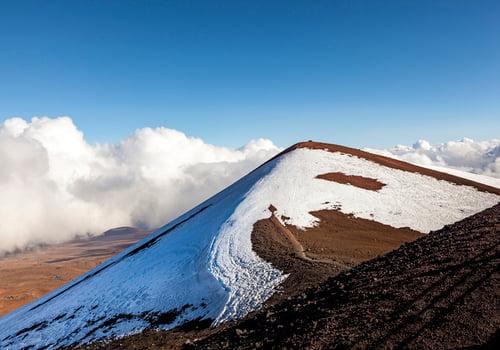Mauna Kea: The Tallest Mountain
Hawaii’s eight islands are the most isolated chain of islands on the planet, and they sit right in the middle of the Pacific Ocean. Crowning the Pacific Ocean is the Ring of Fire; a series of connected fault lines that is responsible for many of Earth’s most devastating quakes.
 Being the centerpiece of the Ring Of Fire is fitting for the Hawaiian islands. After all, each of these isles was forged by fire. At the bottom of the sea, shifting plates crack open the earth to spew forth lava, and the molten rock has found its way to the surface in the form of volcanoes. And these volcanoes have given birth to Hawaii.
Being the centerpiece of the Ring Of Fire is fitting for the Hawaiian islands. After all, each of these isles was forged by fire. At the bottom of the sea, shifting plates crack open the earth to spew forth lava, and the molten rock has found its way to the surface in the form of volcanoes. And these volcanoes have given birth to Hawaii.
But the islands have a life cycle. The volcanoes have been extinguished on Kauai, Oahu, Niihau, Lanai, Molokai and Kahoolawe. Every burst of wind, human footstep and drop of rain erodes these islands back into the sea. In the distant future, each of these islands will be just the peak of a long-dead volcano sticking out of the waves like Molokini Crater off the coast of Maui..
There’s still one island where the fire is alive. In fact, the volcanic activity on The Big Island grows the isle by 40 acres per year. And it’s most indomitable volcano is perhaps the largest mountain on earth -- Mauna Kea.
Sheer Size
 Mauna Kea officially rises 13,803 feet above the waves of the Pacific Ocean, but that doesn’t even begin to tell the whole story. Mauna Kea is a volcano that has burst through the waves all the way from the sea floor. And when you measure its true size, you get a much bigger picture.
Mauna Kea officially rises 13,803 feet above the waves of the Pacific Ocean, but that doesn’t even begin to tell the whole story. Mauna Kea is a volcano that has burst through the waves all the way from the sea floor. And when you measure its true size, you get a much bigger picture.
Mauna Kea, measured from its base at the bottom of the Pacific Ocean in the middle of the Ring of Fire, stands 33,500 feet. That’s more than 10,000 meters, and it’s approximately 4,300 feet taller than Mount Everest.
You know the saying, “It’s the tip of the iceberg.” Well, that applies to what you see of Mauna Kea. There’s more than 19,700 feet of mountain underneath the waves, and the mountain continues to get wider and wider the deeper you go.
The Big Island
 Mauna Kea’s long, slow slopes are a wonder to behold. The mountain simply consumes the horizon which makes it look as if the earth has simply bent upwards towards the heavens. In fact, it’s difficult to get a vantage point of Mauna Kea where the mountain actually looks like a mountain. It’s that big.
Mauna Kea’s long, slow slopes are a wonder to behold. The mountain simply consumes the horizon which makes it look as if the earth has simply bent upwards towards the heavens. In fact, it’s difficult to get a vantage point of Mauna Kea where the mountain actually looks like a mountain. It’s that big.
And Mauna Loa sits right next to Mauna Kea. The sister peak is only about 200 feet shorter, but, unlike Mauna Kea, Mauna Loa is still an active volcano. In fact, Mauna Loa is the world’s largest active volcano and has erupted 33 times since records started back in 1843. Mauna Kea hasn’t erupted since 2460 BC, so it’s safe to assume that the massive mountain’s fire has gone out.
Sister Mountains Provide Array Of Terrains
 The two massive mountains that make up The Big Island provide for a stunning array of terrains. In fact, the strata of elevations provided by Mauna Kea and Mauna Loa allow the Big Island to contain 10 of the world’s 14 different climate zones. You’ll find rainforest, desert and even snow on the Big Island’s peaks during wintertime.
The two massive mountains that make up The Big Island provide for a stunning array of terrains. In fact, the strata of elevations provided by Mauna Kea and Mauna Loa allow the Big Island to contain 10 of the world’s 14 different climate zones. You’ll find rainforest, desert and even snow on the Big Island’s peaks during wintertime.
And that’s what makes the Big Island so fascinating. You only need to drive a few minutes to explore an entirely different ecosystem. A simple drive over the saddle between Mauna Kea and Mauna Loa from Kona to Hilo is an eye-opening experience.
The mountains control the climate on the island. Kona, sitting on the western side of The Big Island, is a dry, hot desert landscape full of volcanic rock fields. On the eastern shores, you’ll find Hilo sitting in a rainforest next to a river. The two cities couldn’t feel more different, and it’s all owed to the towering might of Mauna Kea and Mauna Loa.